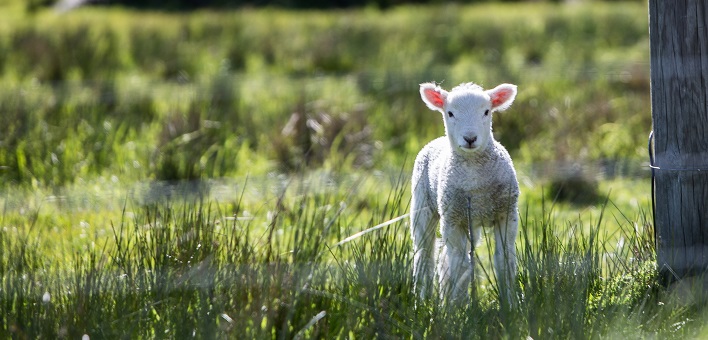Commentary on Psalm 23
Many of us can only hear the first line of the Psalm in the King James Version (KJV): “The Lord is my shepherd, I shall not want.”1 With a simple metaphor in a concise and elegant line, this verse expresses the message of the entire psalm: Yahweh satisfied every need. The images shift throughout the poem, but that central idea remains constant.
Indeed, Psalm 23 delivers some of the most beautiful and deeply comforting images in the whole Bible. As such, this psalm is a favorite—indeed, the favorite—of many.2 But the imagery in this psalm is also full of surprises. So our reading and preaching of this text should not be sentimental, but bold, always keeping in mind the ways that its radical claims confront our experiences of suffering, fear, enmity, and alienation.
The enduring appeal of Psalm 23
The pastoral metaphor at the outset of Psalm 23 resonates so deeply with Christians because of texts like John 10:11 (the Gospel reading for this Sunday) and John 21:15-17. The history of Christian art has played its part as well, reinforcing and developing this image of Jesus as the Good Shepherd through countless iterations. Having encountered all of these images of Jesus holding and caring for sheep, it’s hard for us not to associate Jesus as the shepherd in verse 1.
We can also attribute the psalm’s popularity to its happy ending. With rhetorical flourish, the psalm describes a blessed present and a blessed future, filled with the enjoyment of God’s presence: “Surely goodness and mercy shall follow me all the days of my life and I shall dwell in the house of the Lord my whole life long!” (verse 6, NRSV). The venerable KJV, which so many of us know, in fact, seems to suggest that a beatific afterlife is in view: “I shall dwell in the house of the Lord forever.”
Preaching such a popular text is dangerous, for sentimentalism can easily supplant exegesis. When that happens, our well-worn readings tend to mute the fresh word from God to the contemporary community. Thus we proceed with caution in mapping the structure and imagery of the text.
The journey of the Psalmist
The pastoral images that dominate the beginning of the psalm (shepherd, the verdant fields, and the waters of repose) actually work together to describe a journey that Yahweh oversees and guides. The rest in green pastures is in fact but a temporary repose (verse 2a). This psalmist is on the go, walking beside the water, along paths, and through valleys (verses 2-4).
After the description the blessing that awaits the psalmist in the house of the Lord (verse 5), the text again pictures the psalmist in motion: “Surely goodness and mercy will follow me all the days of my life” (KJV). The word “follow” here (radaph) is better translated “pursue,” a surprising verb given that it is usually the enemies that are pursing the psalmist with an intent to overtake and destroy (e.g., Psalms 7:1; 35:3; 143:3). Furthermore, in this same verse, the word “surely” (’aq) is better translated “only.” Thus it’s not the enemies in hot pursuit. Instead, “only goodness and mercy will be chasing me down.”
The imagery of the final line of the psalm (verse 6b) also deserves another look. For most readers, the end of the psalm provides a picture of an unending bliss in the house of the Lord. The KJV is the basis for the NRSV translating the word shuv as “dwell” here. Some scholars reckon this to be a unique usage of the word shuv, claiming that it indicates a “return with the desire to stay where one ends up.” So, “I will dwell in the house of the Lord my whole life long” (NRSV). Yet others rightly understand shuv here in its most simple sense: “to turn” or “return.” Given the prevalence of images of travelling throughout the psalm, it is most appropriate to read the last line this way: “I will continually return to Yahweh’s presence, my whole life long.” Thus the journey does not end at the end of the psalm. Rather, seeking after God’s presence is a lifelong enterprise, a long-term journey.
This journey consists of the “paths (ma‘galim) of righteousness.” Interestingly, when ma‘galim appears in the rest of the Hebrew Bible, we find it translated “tracks” or “entrenchments,” or even “ruts” that are made by the wheels of an ox-cart — the word ma‘galim is in fact related to the word for young cow, ‘egel. Thus, the “paths of righteousness” are more like ruts in the ground, groves for the wheels of your ox-cart. So, walking with Yahweh is finding your groove, and a righteous groove at that! To get into the righteous groove is to live in a way that promotes and sustains right relationships all around you, with the community and with God. To live this way glorifies the name (or the reputation) of God: “He leads me in paths of righteousness for his name’s sake.”
Jesus as shepherd and trailblazer
As Christians who read and preach this text, we must consider Jesus not only as the good shepherd of John 10, but also as the trailblazer of the paths of righteousness (see Hebrews 12:1-2). Jesus tends us and guides us into right relationships with each other and with God. In the psalm, the paths of righteousness do not lead directly from the green pastures to the house of the Lord. No, those righteous ruts go through the very darkest valley (verse 4). In Jesus’s case, the paths of righteousness lead all the way to the cross. Jesus has shown us that way (see especially 1 John 3:16-24, another lection for this Sunday) and calls us to follow him. The good news of Psalm 23 is that when we walk these paths of righteousness, we walk with God (verse 4).
Notes
- Commentary first published on this site on April 26, 2015.
- For an extraordinary discussion of the ascendancy of Psalm 23 in American culture, see William Holladay, “Epilogue: How the Twenty Third Psalm Became and American Secular Icon” in The Psalms through Three Thousand Years: Prayerbook of a Cloud of Witnesses (Minneapolis: Fortress, 1996), 359-371.


April 25, 2021